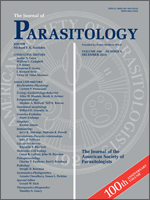Living and fixed samples of Schistosoma mansoni–infected Biomphalaria glabrata snails were used to determine the relative contributions of different snail tissues to cercarial emergence (shedding). Three methods of observations were employed: (1) direct microscopical observations of shedding snails; (2) microscopic analysis of 5 μm serial sections (H&E stained) of actively shedding snails; and (3) scanning electron microscopic (SEM) observations of snails that were fixed while actively shedding. For this investigation, there were advantages and disadvantages to using each method. We confirmed the results of others that there were 3 tissues of the snail that contributed most prominently to cercarial release (mantle collar, pseudobranch, and headfoot). Based on histological analysis of cercarial accumulations in presumed shedding sites in these 3 tissues, 57% of the cercariae could be seen in the mantle collar, 30.6% in the pseudobranch, and 12.5% in the headfoot. Other anterior structures were involved to a much lesser extent. SEM observations clearly showed cercariae emerging either body first, tail first, or likely emerging en masse from blebs, especially from the mantle collar. These studies provide a more quantitative appraisal of the role the different anterior snail tissues play in cercarial emergence.
BioOne.org will be down briefly for maintenance on 17 December 2024 between 18:00-22:00 Pacific Time US. We apologize for any inconvenience.
How to translate text using browser tools
1 December 2014
Determination and Quantification of Schistosoma mansoni Cercarial Emergence from Biomphalaria glabrata Snails
Matthew S. Tucker,
Fred A. Lewis,
James D. Driver,
Willard O. Granath
ACCESS THE FULL ARTICLE

Journal of Parasitology
Vol. 100 • No. 6
December 2014
Vol. 100 • No. 6
December 2014




